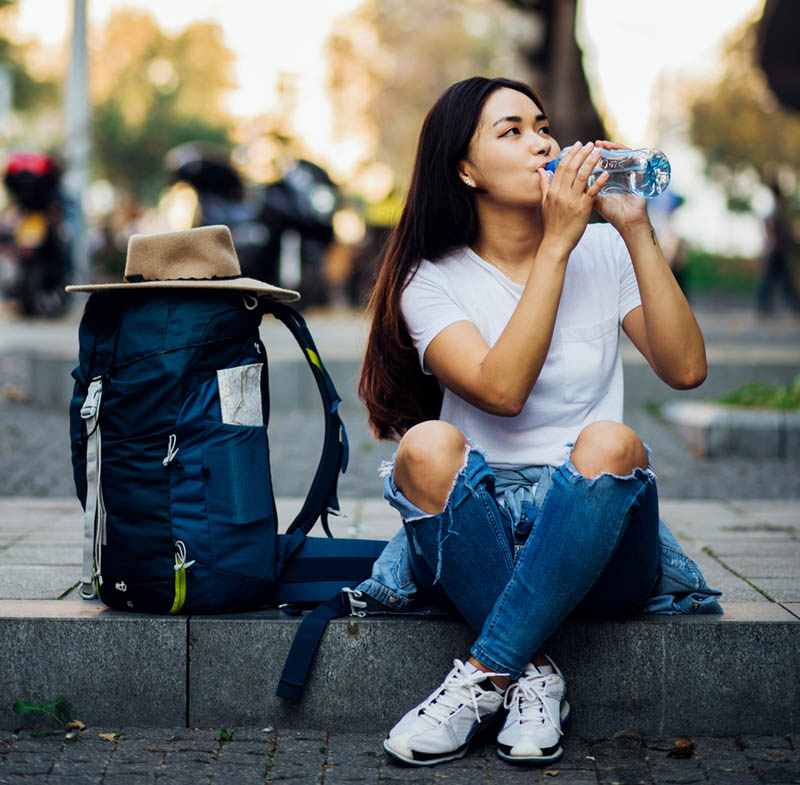Avoid Contaminated Water During Travel

Illnesses caused by contaminated water can ruin your trip. Drinking contaminated, or unclean, water can make you sick with diarrhea, vomiting, and stomach pain. You can get sick if you use contaminated water for cooking, washing food, preparing drinks, making ice, or brushing teeth. Contact with contaminated water, such as wading or swimming, can also lead to illness. Read on for steps you can take to avoid getting sick from water-borne diseases on your travels.
Know Where Your Drinking Water Comes From
When traveling abroad, know where your water comes from. Contaminated water can look clean but still have harmful bacteria, viruses, and parasites. Factory-sealed bottled water is the safest option for most travelers. However, some bottled water can be risky depending on where the bottled water comes from and how it has been treated. Always look for unopened, factory-sealed bottled water or other drinks.
Avoid Contact with Contaminated Water
Take the following steps when traveling to avoid getting sick from contact with contaminated water. Avoid swimming or wading:
- Near storm drains.
- In water that may be contaminated with sewage, human or animal feces and urine, or wastewater runoff.
- In lakes or rivers after heavy rainfall.
- In freshwater streams, canals, and lakes.
- In warm seawater if you have open cuts or wounds. Breaks in the skin can let harmful germs into your body.
Do NOT swim if you have diarrhea. Any amount of infected fecal matter (poop) can contaminate an entire pool or hot tub and make others sick if they swallow the water.
Learn How to Treat Your Water
There are many ways you can treat or purify contaminated water when traveling.
Common Diseases Caused by Contaminated Water
Boiling
Boiling is the best method to kill disease-causing organisms, including viruses, bacteria, and parasites.
- Bring water to a full rolling boil for 1 minute. If you are at an elevation above 6,500 feet, boil water for 3 minutes. Allow the water to cool before you use it.
- If you cannot boil water, use tap water that is too hot to touch, which is probably at a temperature between 131°F (55°C) and 140°F (60°C). This temperature may be adequate to kill pathogens if the water has been kept hot for some time.
- Bring a small electric heating coil or a lightweight beverage warmer with you to boil water if you have access to electricity
Disinfection
If you cannot boil your water, use a chemical disinfectant, such as unscented household chlorine bleach and iodine and iodine-containing tablets, to make a small amount of filtered water safe to drink.
Do NOT drink water that has been disinfected with iodine if you are pregnant, have thyroid problems, or have a known hypersensitivity to iodine. Also, do not use it for more than a few weeks at a time.
- Disinfectants can kill most harmful or disease-causing viruses and bacteria, but they are not as effective with resistant organisms, such as Cryptosporidium and Giardia parasites.
- Chlorine dioxide tablets can be effective against Cryptosporidium if the manufacturer’s instructions are followed correctly.
- If the water is contaminated with a chemical, disinfectants will not make it drinkable.
Filtration
If you are using a portable water filter, try to use one that has a small filter pore size to remove parasites. Most portable water filters do not remove bacteria or viruses.
- A filter (certified by NSF Standards 53 or 58) will remove parasites if it is used properly. It will not remove viruses or all bacteria.
- Use reverse osmosis filters to remove bacteria and viruses. They can also be used to remove salt from water.
- Always follow the manufacturer’s instructions when using filters and check the label of your filter product.
Ultraviolet Light (UV Light)
Ultraviolet Light (UV Light) can be used to kill some pathogens.
- Portable units that deliver a measured dose of UV light help disinfect small amounts of clear water. However, this technique is not recommended for cloudy water because small particles may block germs from the light.
- Always follow the manufacturer’s instructions.
Solar Disinfection
In emergencies, sunlight in the UVA range can improve the quality of water. This is done by filling 0.3-2.0 liter plastic soda bottles with clear water, shaking them to oxygenate, and placing the bottles on a roof or rack for 6 hours (if sunny) or 2 days (if cloudy).
Solar disinfection does not work on cloudy, opaque water. If the headlines in a newspaper cannot be read through the bottle of water, the water will need to be filtered before solar disinfection can we used.
Learn more about germ size, filtration type, and disinfection techniques.
More Information
- CDC Yellow Book: Water Disinfection
- Healthy Water: Water Treatment Options when Hiking, Camping or Traveling
- Swimming and Diving Safety
- Choose Safer Food and Drinks